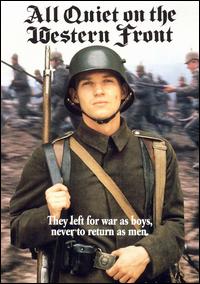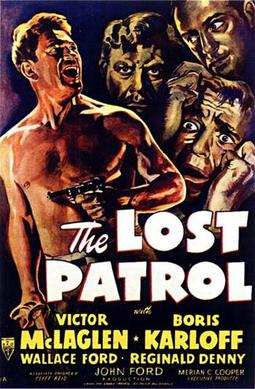VS.
REALISM: “Paths of Glory” is a realistic depiction of the state
of the French army in 1916. Although not
a true story, it is an accurate indictment of French command and tactics. The big battle is as close as a WWI movie
comes to the horrors of crossing no man’s land under a torrent of shot and
shell. The subsequent court-martial of
three soldiers is designed to punish the unsuccessful unit.
This is not particularly realistic, but did happen. All of the armies used the threat of
execution to “motivate” the men. Where
the movie is strongest is its portrayal of the brass. Generals Broulard and Mireau represent the
crass attitude some French generals had toward their charges. The pigheaded frontal tactics are spot
on. The execution of men for cowardice
in spite of extenuating circumstances is sadly not an aberration. GRADE - A
“Westfront, 1918” does a good job enlightening the
audience about conditions on the Western Front.
Director Georg Pabst was famous for his sober realism. The trenches and no man’s land look like you
might see in a documentary. The movie
adds little touches that indicate the screenwriter knew his war. There is a messenger dog. The soldiers spend time picking lice. A main character gets shell shock. GRADE - A
FIRST
QUARTER SCORE: Paths -
9 Westfront - 9
DIALOGUE: The dialogue in “Paths” is crackling. This is a good thing because the movie is
mostly a courtroom drama which means it is dialogue driven. Broulard is a loathsome character not just
for what he does, but also for what he says.
The whole cast gets to share in the many quotable lines in the film. When Broulard asks if his men are men or
mice, Dax responds: “If I had the choice
between mice and Mausers, I’d take the mice.”
When Paris ruminates about his life prospects compared to a roach,
Ferrol smashes the roach and says: “Now
you have the edge on him.” The contrast
between what the idealist Dax says with regard to the war and what the generals
say leaves little doubt about the nature of the war. GRADE - A+
“Westfront” is not dialogue driven. It has a dearth of standout quotes, although
the final conclusion of “it’s everyone’s fault” is a great summation of the
war. The movie is more interested in
depicting the soldier experience at the front and in combat than in giving them
voices. Considering this, we can be
thankful that what dialogue there is is not sappy. The men talk like soldiers probably because
many of the actors were veterans. GRADE
- B
HALFTIME
SCORE: Paths -
19 Westfront - 17
SOLDIER
BEHAVIOR: “Paths” is not a
movie about soldier life. It spends much
of its time on the behavior of the commanders.
The three condemned soldiers well-represent the common poilu. However, there is little coverage of the men
in the trenches. The behavior of the men
pre-battle, during the battle, and after the battle is a tutorial on the French
army in 1916. The “lambs led to
slaughter” aspect is predictive of the mutinies that roiled the army one year
later. The most telling scene is the
final scene where a hooting crowd at a cantina is silenced and brought to tears
by the singing of a German chanteuse. GRADE
- B
“Westfront” was released the same year as “All Quiet”
and has similar themes. It concentrates
on a small group of men, too. An
advantage “Westfront” had was it was a German movie about German soldiers. That might explain why it is more cynical and
bitter than Milestone’s film. It is just
a matter of degree as both films are excellent in showing the bonding and
comradeship that occurs in the trenches.
“Westfront” depicts the reluctance of soldiers to volunteer. A rare occurrence in a war movie. It also gets the exhaustion of war right. GRADE - A
THIRD
QUARTER SCORE: Paths -
27 Westfront - 26
ENTERTAINMENT: It is amazing that “Paths” was not a big hit when it
was released. It is a classic mainstream
war movie. It has the big battle scene
for combat junkies. It is drama without the melo. The acting is great, as is the dialogue. It tugs the emotions of the audience
effectively. It has no weaknesses. You are entertained when you watch it, but
you also feel you have accomplished something by watching it. It is a bucket list movie. GRADE - A+
“Westfront” is also a must-see war movie. A must-see for war movie fans. Unlike “Paths”, it was not aimed at the
general public. Pabst could not have
conceived of the project as a box office magnet. His direction ended up making the movie very
entertaining from my perspective, but the unremitting grimness reduced its
allure to the average viewer. Note that
it came out the same year as “All Quiet” and yet many less people have seen it. This is a shame, but not surprising
considering that “All Quiet” is more traditionally entertaining than Pabst’s
work. Part of the reason for this is
“Westfront” does not flow smoothly from scene to scene. It is a character-centric film that lacks in
character development a bit. GRADE
- B
FINAL
SCORE: Paths of Glory - 37
Westfront, 1918 - 34
.jpg)



_poster.jpg)

_poster.jpg)


.jpg)



